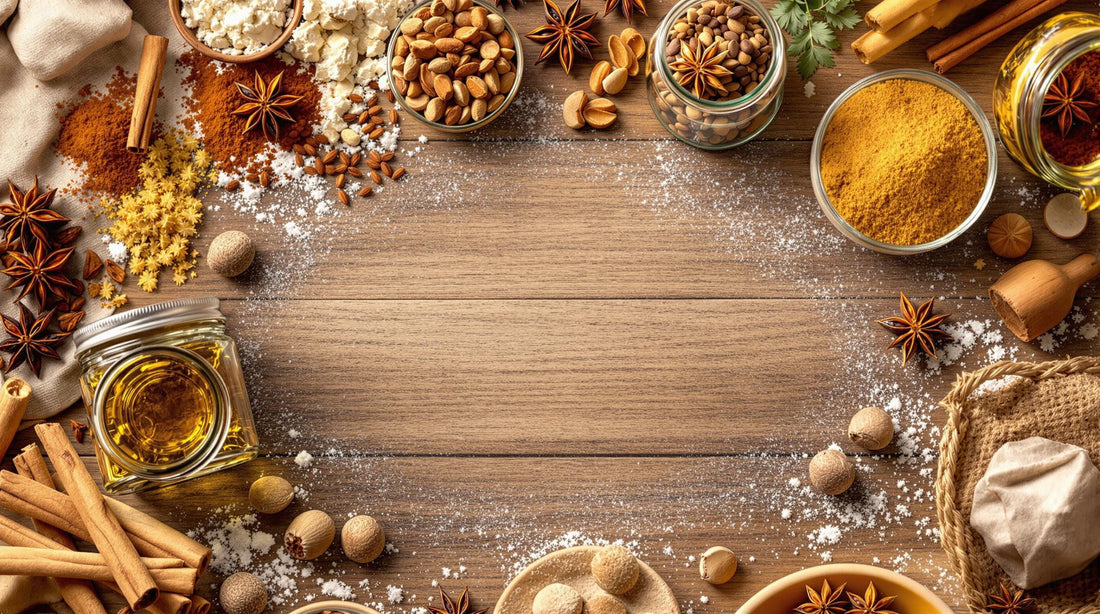
Ultimate Guide to Baking Spices and Extracts
Share
Baking spices and extracts are the secret to creating flavorful, unforgettable desserts. Here's what you need to know to elevate your baking:
- Key Spices: Cinnamon, nutmeg, ginger, and allspice add warmth and depth to recipes.
- Essential Extracts: Vanilla, almond, and lemon extracts enhance sweetness, nuttiness, or brightness.
- Perfect Pairings: Combine vanilla with cinnamon for cookies, or almond with nutmeg for pastries.
- DIY Spice Blends: Mix cinnamon, nutmeg, and ginger in a 4:1:1 ratio for a custom blend.
- Tips for Success: Use fresh spices, high-quality extracts, and measure carefully for balanced flavors.
This guide covers how to choose, use, and combine these ingredients to transform simple recipes into standout creations.
Expert's Guide to Vanilla: Extract, Paste, Powder, and Whole Beans
Guide to Baking Spices
Knowing your baking spices can transform your baked goods, giving them layers of flavor and complexity.
Common Baking Spices and Their Uses
Baking spices offer a variety of flavors that can elevate your recipes. Cinnamon, derived from the bark of Cinnamomum trees, is a staple in baking, often featured in treats like cinnamon rolls and spiced cakes [6]. Ginger, from the root of Zingiber officinale, adds a warm, spicy kick that’s perfect for gingerbread and cookies [4].
| Spice | Origin | Characteristics & Uses |
|---|---|---|
| Cinnamon | Cinnamomum trees | Sweet, woody; ideal for sweet breads, pastries |
| Ginger | Zingiber officinale root | Spicy, warm; great for gingerbread, cookies |
| Nutmeg | Myristica fragrans seeds | Sweet, nutty; perfect for pies, cakes |
| Allspice | Pimenta dioica berries | Warm, complex; enhances sweet breads, desserts |
Nutmeg, from the seeds of Myristica fragrans, adds a sweet and nutty flavor to pies and cakes. Meanwhile, allspice, made from dried Pimenta dioica berries, offers a rich flavor reminiscent of cinnamon, nutmeg, and cloves [2].
According to The Spice House, "Vanilla is a baking essential. Its sweet, floral taste and aroma complements a wide range of ingredients, from chocolate and nuts to fruits and spices" [5]. This makes it a versatile ingredient that pairs beautifully with other spices.
Once you understand the individual characteristics of these spices, you can start blending them to create flavors unique to your baking style.
How to Make Your Own Spice Blends
Creating your own spice blends allows you to add a personal touch to your recipes while achieving balanced flavor combinations. Start by mixing small amounts of spices and adjust until you find the perfect ratio. For example, cinnamon works well as a base, with smaller amounts of nutmeg or ginger added for depth.
To keep your blends fresh, store them in airtight containers in a cool, dry place away from sunlight [7]. Trying spices like cardamom, which is becoming increasingly popular in baking, can add exciting new dimensions to your recipes [5].
| Base Spice | Supporting Spices | Ratio |
|---|---|---|
| Cinnamon | Nutmeg + Ginger | 4:1:1 |
| Ginger | Cinnamon + Allspice | 3:2:1 |
| Nutmeg | Cinnamon + Cardamom | 2:2:1 |
Experimenting with spice combinations is a fun way to develop your own signature flavors in the kitchen.
sbb-itb-c693c43
Using Extracts in Baking
What Are Extracts and How They Are Made?
Extracts are concentrated flavor enhancers that bakers rely on to add depth to their creations. These are made by soaking natural ingredients in alcohol, which pulls out the ingredients' flavors and aromatic compounds over 4-6 weeks [1][6]. This process preserves the flavors in a long-lasting, easy-to-use form.
Must-Have Extracts for Bakers
Vanilla extract is a staple in baking, known for its ability to enhance sweetness and balance other flavors [8]. Almond extract, made from bitter almonds or pits of stone fruits, brings a bold, nutty flavor with a hint of fruitiness [3].
| Extract Type | Flavor Profile | Common Uses |
|---|---|---|
| Vanilla | Sweet, creamy, layered | Cakes, cookies, pastries |
| Almond | Nutty with fruity hints | Pastries, fruit-based desserts |
| Lemon | Bright, zesty, citrusy | Lemon bars, citrus cakes |
If you're feeling adventurous, making extracts at home is simple: combine your chosen ingredient with alcohol and let it steep for several weeks [2].
How to Pair Extracts with Spices
Combining extracts with spices can create well-rounded and exciting flavors. For example, vanilla works beautifully with cinnamon, while almond pairs seamlessly with nutmeg for added depth [3][4].
When trying out new combinations, start with small amounts and tweak as needed. For recipes that require high-temperature baking, opt for extracts designed to hold their flavor during cooking [4].
| Extract | Best Spice Matches | Ideal Uses |
|---|---|---|
| Vanilla | Cinnamon, Nutmeg | Cookies, sweet breads |
| Almond | Nutmeg, Cardamom | Scones, Danish pastries |
| Lemon | Ginger, Allspice | Muffins, fruit cakes |
With these pairings in mind, you can experiment with different blends to create unique and delicious baked goods.
Tips for Using Baking Spices and Extracts
Balancing Flavors
Getting the right balance of spices and extracts can make or break your recipe. Always measure carefully and take notes on what works for consistent results. Here’s a quick reference for some common ingredients:
| Spice/Extract | Starting Amount | Maximum Recommended |
|---|---|---|
| Ground Cinnamon | 1/4 teaspoon | 1 teaspoon per cup of flour |
| Vanilla Extract | 1/2 teaspoon | 1 tablespoon per recipe |
| Almond Extract | 1/8 teaspoon | 1/2 teaspoon per recipe |
Keep in mind that the strength of extracts can vary depending on the brand and whether they’re pure or imitation versions [3].
Trying New Flavor Combinations
Mixing spices and extracts in creative ways can take your baking to the next level. Start small with test batches and jot down your results in a baking journal. For a seasonal twist, try warming spices like cinnamon, nutmeg, and cloves in winter recipes. In spring, lighter flavors like lemon or lavender can brighten up your creations [1].
Helpful Tools for Baking
To use spices and extracts effectively, make sure you have the right tools on hand:
- Precision measuring spoons for accurate amounts
- A fresh spice grinder to unlock maximum flavor
- Airtight storage containers to keep spices fresh
An apron with adjustable straps and pockets, such as those from Cosmic Aprons, can also be handy for keeping tools close by and your workspace tidy.
For best results, store spices in airtight containers away from heat and light. Use bake-proof extracts if you’re working with high-temperature recipes [4]. With the right setup and a bit of care, your baked goods can stand out with bold and delicious flavors.
Conclusion
Summary of Key Points
Using baking spices and extracts effectively opens up a world of flavor possibilities. Pure vanilla extract is a staple for most recipes, while almond and lemon extracts bring their own unique touches to baked goods. By learning how to balance the strength of each ingredient and understanding how they work together, bakers can create flavors that are both delicious and personal.
Choosing high-quality extracts and fresh spices is key to making baked goods taste their best. Each ingredient offers a chance to experiment and develop distinctive flavor combinations. With practice, bakers can turn simple recipes into standout creations that showcase their skills and creativity.
Additional Resources
Want to learn more? Check out resources like Spice Jungle and Savory Spice Shop, or dive into books like The Science of Spice for detailed guidance on baking ingredients and techniques [7][4][9]. These tools can help you explore flavor pairings and improve your baking expertise.
Experimenting with spices and extracts is a fun way to discover exciting new flavors. Start small, keep notes, and enjoy developing your own signature baking style.
